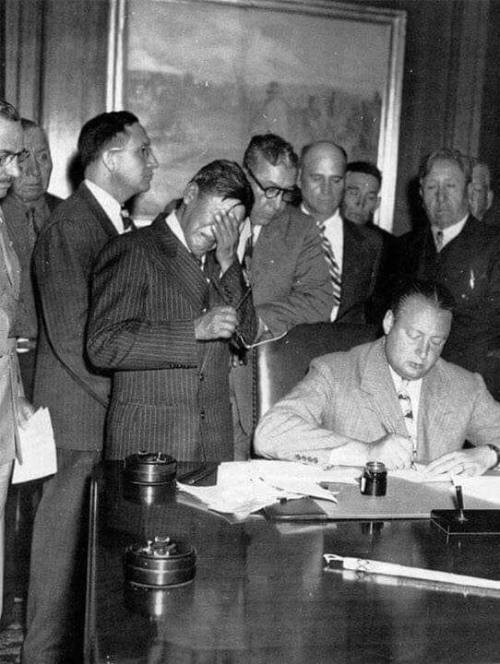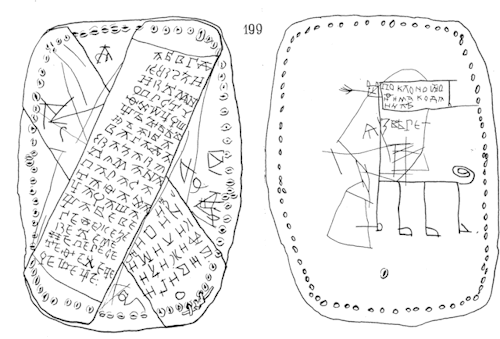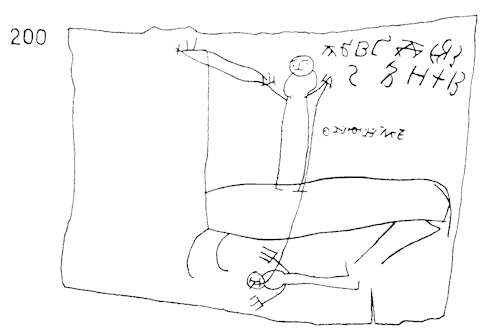Uncredited Photographer Headquarters Of The German Communist Party (KPD), Featuring The Logo Of The KPD's

Uncredited Photographer Headquarters of the German Communist Party (KPD), Featuring the Logo of the KPD's Anti-fascist Paramilitary Group, Antifaschistische Aktion, Berlin 1932
More Posts from Superkarakortada and Others

El IV Reich?

En pocas ocasiones se han llegado a mostrar con tanta intensidad los dolores, alegrías e inquietudes interiores de una persona, a través de un instrumento musical, como lo hizo John Coltrane. El saxofón tenor y el soprano vibraron con tanta fuerza, cuando él los tocaba, que crearon algunos de los momentos más intensos y emocionantes de la Historia del Jazz.

“I sing of Spain and I feel it to the core; but before this I am a man of the world and brother of all”.
In his youth frequenting Els Quatre Gats, Lluís Bagaria was a self taught Spanish illustrator born in Barcelona in 1882. In the 1910-20’s he was considered the most important Spanish political caricaturists. Lluis was also friend to Federico García Lorca, whom he interviewed for the newspaper El Sol shortly before his assassination. Born in Barcelona, it was later in Madrid where he achieved great popularity and fame. His caricatures against fascism during the Spanish Civil War provoked his exile to Paris and into Cuba. At age 57, In 1940, after recently arriving in Havana Lluis died in exile, an anti fascist to the end.


Elliott Erwitt con su perro y la famosa foto del beso a través del espejo retrovisor...

Walter Gropius, fundador de la bauhaus, en sus años de estudiante...
Por desgracia, siempre hacen lo mismo. No pueden permitir que otros pueblos prosperen.

The man crying is George Gillette, tribal chairman of the Mandan, Arikara, and Hidatsa tribes of North Dakota in 1948. He was forced under the threat of death of all his people to sign over the tribes’ homeland on the fertile floodplain of the Missouri River in order to build the Garrison Dam.
The final settlement legislation denied tribes’ right to use the reservoir shoreline for grazing, hunting, fishing or other purposes, including irrigation development and royalty rights on all subsurface minerals within the reservoir area.
After the dam was constructed, the three tribes were scattered, their communities and extended families flung to different shores of the 200-mile-long Lake Sakakawea.
This is what your freedom and democracy is built on.
El niño Onfim ha tenido una magnífica forma de pasar a la posteridad... Me encanta!




Back in the 13th century (the writings are estimated to date from 1234 to 1268) a 6/7 year old boy named Onfim, who lived in Veliky Novgorod, left his notes and school assignments scratched on birch bark. These have survived to this day and are written in the old Novgorod dialect. They consist of letters, syllables and drawings of battle scenes, knights, horses, arrows and himself with his teacher. These are clearly school assignments that Onfim was practising.
-
 23665956134257970 liked this · 2 weeks ago
23665956134257970 liked this · 2 weeks ago -
 whenimreallyathundacat reblogged this · 2 weeks ago
whenimreallyathundacat reblogged this · 2 weeks ago -
 captaincoffeegirl515 liked this · 2 weeks ago
captaincoffeegirl515 liked this · 2 weeks ago -
 plaidsquid41030 liked this · 2 weeks ago
plaidsquid41030 liked this · 2 weeks ago -
 tired-pandaa reblogged this · 2 weeks ago
tired-pandaa reblogged this · 2 weeks ago -
 sinsentiu reblogged this · 2 weeks ago
sinsentiu reblogged this · 2 weeks ago -
 27koi liked this · 2 weeks ago
27koi liked this · 2 weeks ago -
 all-purpose-utility-nerd liked this · 2 weeks ago
all-purpose-utility-nerd liked this · 2 weeks ago -
 matthewsac liked this · 2 weeks ago
matthewsac liked this · 2 weeks ago -
 nando161mando liked this · 2 weeks ago
nando161mando liked this · 2 weeks ago -
 robotblues liked this · 2 weeks ago
robotblues liked this · 2 weeks ago -
 shadowpeoplebluntsmoke liked this · 2 weeks ago
shadowpeoplebluntsmoke liked this · 2 weeks ago -
 systm420 liked this · 2 weeks ago
systm420 liked this · 2 weeks ago -
 da-riya liked this · 2 weeks ago
da-riya liked this · 2 weeks ago -
 kropotkindersurprise reblogged this · 2 weeks ago
kropotkindersurprise reblogged this · 2 weeks ago -
 fixy8ed4xys liked this · 3 weeks ago
fixy8ed4xys liked this · 3 weeks ago -
 thedeepestshadeofmushroomblue reblogged this · 2 months ago
thedeepestshadeofmushroomblue reblogged this · 2 months ago -
 kropotkindersurprise liked this · 2 months ago
kropotkindersurprise liked this · 2 months ago -
 nicoeben liked this · 2 months ago
nicoeben liked this · 2 months ago -
 parkerfinn liked this · 2 months ago
parkerfinn liked this · 2 months ago -
 gempapaamx liked this · 3 months ago
gempapaamx liked this · 3 months ago -
 trannytitties5ever liked this · 3 months ago
trannytitties5ever liked this · 3 months ago -
 jinruihokankeikaku reblogged this · 3 months ago
jinruihokankeikaku reblogged this · 3 months ago -
 jinruihokankeikaku liked this · 3 months ago
jinruihokankeikaku liked this · 3 months ago -
 saganshy liked this · 3 months ago
saganshy liked this · 3 months ago -
 eluvar reblogged this · 3 months ago
eluvar reblogged this · 3 months ago -
 funduspour reblogged this · 3 months ago
funduspour reblogged this · 3 months ago -
 uuneya liked this · 3 months ago
uuneya liked this · 3 months ago -
 unityuniverse reblogged this · 3 months ago
unityuniverse reblogged this · 3 months ago -
 unityuniverse liked this · 3 months ago
unityuniverse liked this · 3 months ago -
 technofeudalism reblogged this · 3 months ago
technofeudalism reblogged this · 3 months ago -
 technofeudalism liked this · 3 months ago
technofeudalism liked this · 3 months ago -
 wurstfighter liked this · 3 months ago
wurstfighter liked this · 3 months ago -
 auf-heben reblogged this · 3 months ago
auf-heben reblogged this · 3 months ago -
 vogelmilch reblogged this · 3 months ago
vogelmilch reblogged this · 3 months ago -
 dyskomike liked this · 3 months ago
dyskomike liked this · 3 months ago -
 qaikele liked this · 3 months ago
qaikele liked this · 3 months ago -
 gladiopsyop liked this · 3 months ago
gladiopsyop liked this · 3 months ago -
 katya-1917 liked this · 3 months ago
katya-1917 liked this · 3 months ago -
 2young2die reblogged this · 3 months ago
2young2die reblogged this · 3 months ago -
 dirkdecker liked this · 3 months ago
dirkdecker liked this · 3 months ago -
 anco-comrade liked this · 3 months ago
anco-comrade liked this · 3 months ago -
 tatrat3 liked this · 3 months ago
tatrat3 liked this · 3 months ago -
 pierrebotardo liked this · 3 months ago
pierrebotardo liked this · 3 months ago -
 tovarishfungus reblogged this · 3 months ago
tovarishfungus reblogged this · 3 months ago -
 tovarishfungus liked this · 3 months ago
tovarishfungus liked this · 3 months ago



